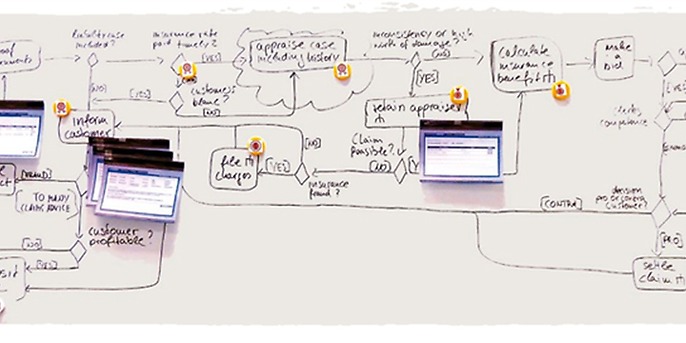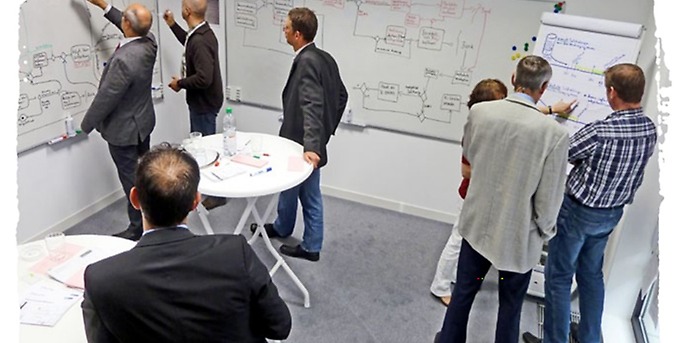3. February 2020 By Başak Akbulak
DIGITAL TRANSFORMATION, ITS PHASES AND THE INTERACTION ROOM METHODOLOGY
“Change is the only constant in life.” — Heraclitus, a Greek philosopher
In a world where everything is interconnected, our lives can change faster than the speed of light. This includes the way we communicate, our daily lifestyles, the language we use, and most importantly, the way we do business.
These changes are the result of technological advancements. We live in a world where every individual can use and manipulate technology in their favour. IT is no longer a VIP club with only a few members — now, the whole world has access to IT. In other words, the world as we know it has changed remarkably with technology affecting everything. So what’s next?
The beginning of the fourth industrial revolution has heralded the rise of AI, IoT, blockchain, and other advanced technologies. This has led to discussions about how these new technologies can be leveraged to change the business world. The future is already here and among us lies the technologies we have dreamt of and talked about for centuries. However, the business world still has a long way to go in order to fully embrace digital transformation.
How to Understand and Adopt Digital Transformation
Transformation is a layered and continuous journey where there is no destination. As long as new technologies are being developed, digital transformation will be a necessity.
Understanding Digital Transformation
The idea that integration with new technology is the best solution to all our problems is a misconception for three reasons.
- Not all problems require a complex, totally new and trendy technology as a solution.
- The timing needs to be right in order to integrate a new and complex technological infrastructure. Despite this, transformation alone is not any good when we cannot adapt.
- The adoption of new technology is not an easy and fast-paced process because this phase doesn’t just require technology, but people with expertise and the willingness to change. Change can be hard for many people to accept. This is why agility is important when it comes to digital transformation.
Traditional vs. Agile
Traditionally, people work with plan-oriented projects, which have little to no space for change because every step is perfectly calculated and even a small change will cause big problems. In contrast, a fully agile model offers a new model where change is welcomed and is part of the process. However, a fully agile model cannot always be implemented because some questions cannot be answered before the project begins, such as the deadline, requirements and budget plan.
When examined separately, these two concepts both seem extreme, so it is important to find a balance in between: the sweet spot. In today’s business world, this sweet spot changes according to each organisation’s needs. The scope of projects should also be determined on an organisation-specific level when planning their digital transformation.
This is where real digital transformation comes in. We leave the ‘one size fits all’ mindset behind and start honing in on specific technologies for individual organisations. The digital transformation journey requires a deep understanding of all stakeholders within an organization in order to achieve full alignment. Every stakeholder will come with many questions: How do we do that? How long will it take? How are we supposed to get everyone aligned? Which technologies should we use? How much resource will this require? What will be the gain? What are the problems? What are the solutions?
The Interaction Room (IR) Methodology
Our answer lies in the Interaction Room (IR) methodology. This is a method developed by adesso AG and paluno (The Ruhr Institute for Software Technology at the University of Duisburg-Essen), which helps companies on their digital transformation journey by focusing on their key priorities: what the company needs and what brings the greatest business value.
In more general terms, IR takes design thinking and requirement engineering techniques and uses a flexible framework to structure a digital transformation roadmap. One of the strongest features of IR is its facilitation of communication among different parts of an organisation in order to achieve stakeholder alignment. The idea behind the Interaction Room is to create an environment for cross-functional teams to come together into a discussion. These discussions will provide a shared foundation of understanding and align all key stakeholders on decisions and outputs.

For the best results, the Interaction Room should be held in an open space with the participation of all stakeholders and the usage of supporting tools. The IR method requires a range of supporting tools, including customer journey map, process map, object canvas, integration map, personas, and many more. Each tool has a specific purpose.
- Customer journey map is used to visually represent every phase the customer goes through when interacting with the organisation’s services or products.
- Process map sequentially visualises each step of the examined operation in detail.
- Personas are used to illustrate every individual or company that the organisation interacts along the way.
The moderator will handpick each tool according to the specific needs of the organisation.
Interaction Room — Workshop Flow
The workshop starts by placing canvases on the wall where everyone can see. Participants then share their ideas on each subject that is being discussed. They can also bring up another subject that has not been mentioned but should be examined as it falls under the scope of the project. Afterwards, everyone generates ideas for the solutions and writes them on the canvases to share.
All participants will then discuss each idea and vote on their level of importance. The results will form the basis of the digital roadmap, which will guide the organisation through their digital transformation.

The roadmap is a complete action guide for realising the solutions found in IR. The roadmap includes a timeline of short, medium, and long-term actions according to their budget requirements and priority. Key Priorities are evaluated by their business value and cost-effectiveness.
To summarise, IR helps organisations to stay focused on the right action at the right time, so projects can be launched to deadline and within budget with full alignment from all key stakeholders.

